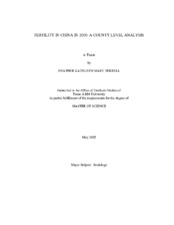| dc.description.abstract | In order to maintain itself into the future, the People’s Republic of China undertook in the 1970s a legendary demographic endeavor dealing with the artificial constraint of population growth. The “later, longer, fewer” policy and the more rigid one-child policy were efforts to expedite the demographic transition in the country. The ultimate goal was the stabilization and eventual decline of the population, via fertility at below-replacement levels for an extended period of time. According to the 2000 census, the total fertility rate (TFR) for China was 1.22—well below 2.1, the replacement level of fertility. However, the country’s TFR fluctuated spatially with rates of .86, 1.08, and 1.43, for cities, towns, and rural areas, respectively. Undoubtedly, China’s family planning policy is largely responsible for the nation’s current low fertility, as well as the geographical variation in fertility just mentioned. Research has shown, however, that other factors have played a part in this fertility transition and the subsequent variation at the regional, provincial, and county levels. In keeping with the expectations of demographic transition theory (DTT), quantitative studies conducted over the last twenty years have linked an assortment of socioeconomic factors with China’s fertility decline and nationwide inconsistencies (Birdsall and Jamison 1983; Tien 1984; Poston and Gu 1987; Freedman et al. 1988; Peng 1989; Poston and Jia 1990; Poston 2000). My thesis built on and extended the above work, using the newly available demographic data provided by Census 2000. I tested the efficiency of demographic transition variables in explaining the variation in the TFR among the counties of China by estimating twelve Ordinary Least Squares (OLS) regression equations. Specifically, I examined the ways in which variables such as ethnicity, agricultural detachment, urbanization, economic conditions, cultural norms and gender differences were related to Chinese fertility in a nationwide analysis and in two region-specific analyses. My results showed rather definitively that demographic transition theory is applicable for predicting and understanding fertility among the counties of China. Irrespective of the nation’s extensive family planning policy, it is apparent that other factors contribute to the varying fertility rates across the country. | en |


